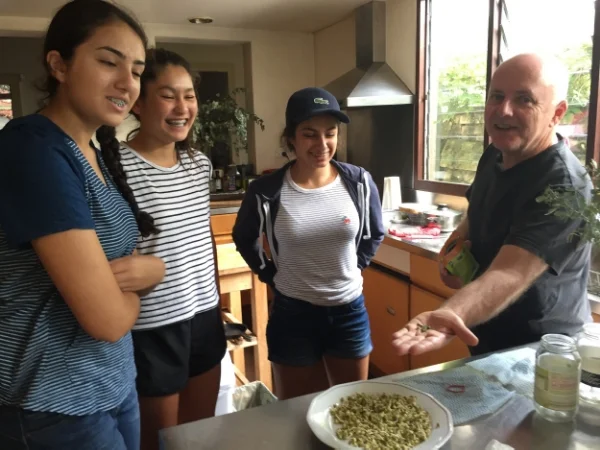Three students road gardened over three weekends in Chippendale's road gardens for their Duke of Edinburgh awards. This is their story.
Guest post
Pruning comfrey with secateurs to mix leaves with water to make compost tea
By Kathrin Germanos, Bianca Bader and Christina Gadalla
31 March 2016
As part of our Duke of Ed requirement for service to the community we once again partook in volunteering at the Chippendale Gardens. The main thing which we got out of today is “ not to waste” and how we are easily able to minimise our waste as things which we often don’t realise, can actually be re used in new and different ways. In addition, we also learnt how to prune, and the importance of mulch especially during Autumn.
The session started off with us trying some mung beans, which we then learnt how to grow from seeds. This was particularly interesting as during the colder months it is harder for plants to grow and thus harder to grow food. The mung bean however is one which we learn could be grown by ourselves to produce food. Furthermore, it is also rich in vitamins and versatile thus can be added to provide extra health benefits to a range of means. Michael’s suggestion being a vegetable slice or salad.
Smashing oyster shells (which have lots of nutrients for plants) to dust to add to compost tea
Next, we discovered another use of oyster shells, which can be added to compost tea, too improve the quality of the compost. We smashed them up using hammers then added them to the tea and went to pour this onto the garden. This tea is made up of a specific plant and then is left to ferment for a couple of days until it becomes aerobic and is rich is nitrogen ( vital for plant survival). This mixture although was quite stinky, was going to help the plants root systems grow during these months. Especially the root system since above ground level doesn’t usually grow so well during this time.
The fertiliser was then covered in mulch which was raked up straight from the chicken coop. A mixture of chicken excrement, worms and straw Michael described it as “gold”. This was then placed once again where we had just put the fertiliser. Around the plants – the main area where the roots extend to.
As for skills, we learnt how to use secateurs safely as this is a vital tool used for pruning. Pruning must be done to help the plants healthy as it opens up the plants and allows for more sunlight and air to pass through the middle of the plant. It also helps to reduce sickness and competition on branches as then the plant doesn’t have to supply nutrients to both branches- as consequently both will become weaker. It is much better to cut off the weaker one so the stronger one can become stronger. This overall increases the plants fruit production as well as survival rate.
We were able to take turns pruning a couple of plants, which we then covered in straw ( at the base of the plant ). This helps it during Autumn and Winter as it gets colder and it acts as a sort of blanket for the plants.
Overall we had a very valuable educational experience, which, although at some stages may have been a little challenging, was eye opening.
We learnt that even the smallest things can make a difference and that most ordinary things can be saved or re-used to stop them from going to landfill. We were able to use these new found skills throughout the day and hopefully are able to harness them for better use in the future.



